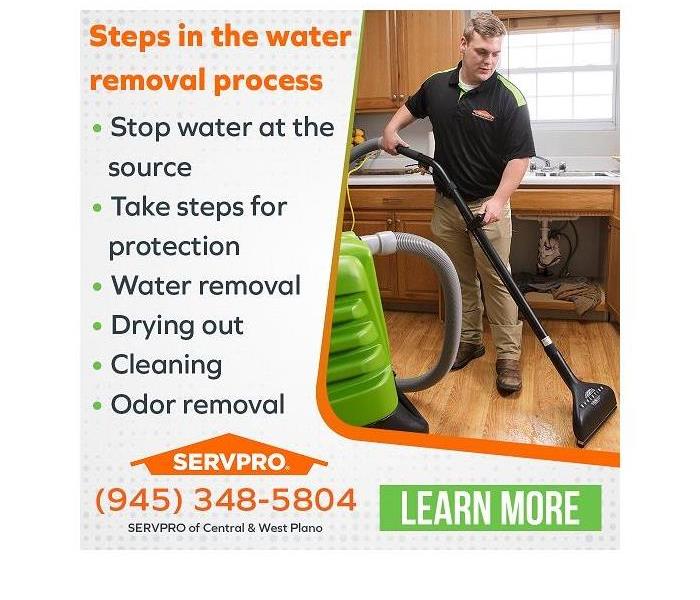How Does the Water Removal Process Work: A Short Guide
10/22/2022 (Permalink)
Blog Summary: SERVPRO® of Central & West Plano outlines the water removal process.
Water damage can cause stress and frustration in those affected. Whether a leaking pipe or flood is affecting the community, the water damage may need a cleanup, which may be overwhelming for many. But water damage demands quick action, as the longer water remains where it should not be, the more damage it can cause. Moisture in the wrong places can cause structural damage to a building and lead to mold growth.
Once water damage is identified, an essential step of the water damage restoration process is water removal. This step is carried out with utmost attention by professionals in the restoration industry because they know that if water removal is not done correctly, secondary water damage can occur. SERVPRO® of Central & West Plano is a professional water damage restoration service that understands the importance of water removal. The professionals at SERVPRO of Central & West Plano follow steps as required by the IICRC (Institute of Inspection Cleaning and Restoration) to prevent further water damage when performing water damage restoration. In this article, the company explains what the water removal process is.
Water removal is the act of removing excess water from areas damaged by water. Water removal is done after assessing the water damage and understanding its severity. It is done immediately, as water removal helps to prevent critical structural damage to the building and speeds up the step of drying that follows in the water damage restoration process. Correctly performed water removal also reduces the risk of mold growth. Since water removal is so necessary, it is best to use a professional restoration company for water removal services. Professionals like SERVPRO of Central & West Plano have the knowledge, experience, and latest industrial-grade tools and equipment for proper water removal in Plano, Texas, and surrounding areas.
Steps in the water removal process
1. Stop water at the source
The source of water that is causing damage is identified and shut down. Moisture sensors and meters may detect hidden water damage and sources.
2. Take steps for protection
Standing water has the potential to cause health issues or other dangers. Personal protective devices must be used if there is any possibility of contamination. Water exposure can lead to electrical system and components problems, which may further lead to electrical hazards or fire. The electricity supply must be switched off, and electricity must be used only after a professional inspects and makes sure it is safe.
3. Water removal
When the water damage is excessive, restoration professionals may move-out belongings to protect them from further damage. Submersible pumps, truck-mounted vacuums, and specialized equipment are used for water removal. The specialized equipment helps efficient water removal. As much water as possible must be extracted to prevent water damage from worsening and mold growth. Professionals may use instruments like infrared cameras to identify hidden water damage. Carpets and carpet pads are inspected to decide if they must be removed to protect the subfloor.
4. Drying out
Floors, walls, and other items must be dried to avoid the warping or swelling of building materials, mold growth, and similar complications. Industrial air movers and dehumidifiers are used to dry out carpets, furniture, drywall, wood, etc. The moisture levels are assessed after this step to ensure humidity is at an average level. Removing excess moisture helps to salvage as many belongings as possible and reduces the cost of water damage restoration.
5. Cleaning
Various techniques and tools are used to clean the home and belongings so that the property is restored to a preloss state as far as possible.
6. Odor removal
A portable air filtration system or air scrubber may help if there are unpleasant odors even after water removal. Disinfection and sanitization are also done.
Water removal is an initial and crucial step of the water damage restoration process. Failure in the water removal process increases the risk of water damage complications. SERVPRO of Central & West Plano has truck-mounted vacuum units and powerful portable extraction units that make the process quick and efficient. To get water removal service in Plano, TX, property owners can dial the phone number (945) 348-5804 and speak to personnel from SERVPRO® of Central & West Plano.






 24/7 Emergency Service
24/7 Emergency Service
